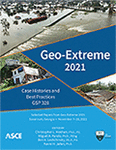Variations in Sediment Strength along the Tidal Inlet Channel near Pea Island, NC
Publication: Geo-Extreme 2021
ABSTRACT
The sound-side shoreline of Pea Island located on the Outer Banks, NC, has been eroding over the last two decades. As part of the pilot During Nearshore Event Experiment (DUNEX) carried out in October 2019, sediment strength, grain size, and currents were measured in a tidal inlet flood channel in the back-barrier zone of Pea Island using a portable free fall penetrometer, grab samples, and an acoustic Doppler current profiler. Results indicate a general trend of a decrease in the surficial (upper 10 cm) sediment strength toward the shoreline (from 130 to 75 kPa) and from downstream to upstream (from 150 to 70 kPa). The cross-shore directed trend can be explained by sediment fining toward the shoreline with a lowest median grain size of 22 μm. Variations in sediment strength were related to current velocities and local sediment transport processes; thus, the results contribute to a better understanding of the erosional processes of the sediments.
Get full access to this article
View all available purchase options and get full access to this chapter.
REFERENCES
Albatal, A., and Stark, N. (2017). “Rapid sediment mapping and in situ geotechnical characterization in challenging aquatic areas.” Limnology and Oceanography: Methods, 15(8), 690–705.
ASTM. ASTM D2487-11. Standard Practice for Classification of Soils for Engineering Purposes (Unified Soil Classification System). ASTM International, West Conshohocken, PA.
Clinch, A. S., Russ, E. R., Oliver, R. C., Mitasova, H., and Overton, M. F. (2012). “Hurricane Irene and the Pea Island Breach: Pre-storm Site Characterization and Storm Surge Estimation Using Geospatial Technologies.” Shore and Beach, 80(2), 38–46.
Dayal, U., and Allen, J. H. (1973). “Instrumented Impact Cone Penetrometer.” Canadian Geotechnical Journal, 10(3), 397–409.
Dolan, R., and Lins, H. F. (2000). “The Outer Banks of North Carolina.” US Geological Survey, 58-110.
Dolan, R., Lins, H. F., and Smith, J. J. (2016). “The Outer Banks of North Carolina.” US Geological Survey,153-289.
Dunn, M., Sciaudone, E., and Velasquez-Montoya, L. (2019) “Estuarine shoreline erosion driven by flood channel proximity at Pea Island, NC.” Proc. American Shore & Beach Preservation Association (ASBPA) National Coastal Conference 2019, Myrtle Beach, SC.
Grabowski, R. C., Droppo, I. G., and Wharton, G. (2011). “Erodibility of cohesive sediment: The importance of sediment properties.” Earth-Science Reviews, 105(3-4), 101–120.
Inman, D. L., and Dolan, R. (1989). “The Outer Banks of North Carolina: Budget of sediment and inlet dynamics along a migrating barrier system.” J. of Coastal Research, 193–237.
NOAA (National Oceanic and Atmospheric Administration). (2019). “USGS current conditions for the nation-station 08114000.” <https://nwis.waterdata.usgs.gov/nwis/uv?>(August 25, 2019).
North Carolina Coastal Federation. (2016) North Carolina’s terminal groins at Oregon Inlet and Fort Macon. North Carolina Coastal Federation.< 20,2020).
Overton, M. (2015). “Coastal monitoring program, NC 12 transportation management plan, TIP project B-2500, 2014 Update Report.”.
Pietrafesa, L. J. (2012). “On the continued cost of upkeep related to groins and jetties.” J. of Coastal Research, 28(5), 3–4.
Riggs, S. R., and Ames, D. V. (2009). “Impact of the oregon inlet terminal groin on downstream beaches of Pea Island, NC Outer Banks.”.
Riggs, S. R., Ames, D. V., Culver, S. J., Mallinson, D. J., Corbett, D. R., and Walsh, J. P. (2009). “Eye of a human hurricane: Pea Island, Oregon inlet, and Bodie Island, northern outer banks, North Carolina.” Geological Society of America Special Papers, 460(4), 43–72.
Safak, I., Warner, J. C., and List, J. H. (2016). “Barrier island breach evolution: alongshore transport and bay-ocean pressure gradient interactions.” J. Geophys. Res. Oceans, 121, 8720–8730.
Sciaudone, E. J., Velasquez-Montoya, L., Smyre, E. A., and Overton, M. F. (2016). “Spatial and temporal variability in dune field: Pea Island, North Carolina.” Shore & Beach, 84(2), 49–58.
Seminack, C. T., and McBride, R. A. (2018). “A life cycle model for wave dominated tidal inlets along passive margin coasts of North America.” Geomorphology, 304, 141–158.
Stark, N., and Wever, T. F. (2009). “Unraveling subtle details of expendable bottom penetrometer (XBP) deceleration profiles.” Geo-Marine Letters, 29(1), 39–45.
Stark, N., and Kopf, A. (2011). “Detection and quantification of sediment remobilization processes using a dynamic penetrometer.” Proc. IEEE/MTS Oceans 2011, Waikoloa, HI.
Velasquez-Montoya, L. V., Sciaudone, E. J., Mitasova, H., and Overton, M. F. (2018). “Observation and modeling of the evolution of an ephemeral storm-induced inlet: Pea Island Breach, North Carolina, USA.” Continental Shelf Research, 156, 55–69.
Velasquez-Montoya, L., Overton, M. F., and Sciaudone, E. J. (2020). “Natural and anthropogenic-induced changes in a tidal inlet: Morphological evolution of Oregon Inlet.” Geomorphology, 350(1), 106871.
Velasquez-Montoya, L., Sciaudone, E. J., Smyre, E., and Overton, M. F. (2021). “Vulnerability indicators for coastal roadways based on barrier island morphology and shoreline change predictions.” Natural Hazards Review, 22(2): 04021003.
Information & Authors
Information
Published In
Copyright
© 2021 American Society of Civil Engineers.
History
Published online: Nov 4, 2021
Authors
Metrics & Citations
Metrics
Citations
Download citation
If you have the appropriate software installed, you can download article citation data to the citation manager of your choice. Simply select your manager software from the list below and click Download.
